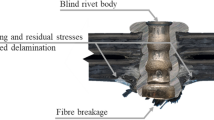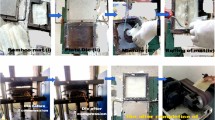Abstract
A new approach for determining effective mechanical bondline properties using a combined experimental–numerical modal analysis technique is proposed. After characterizing clear spruce wood boards, an adhesive layer is applied to the boards’ surfaces. The shift of the eigenfrequencies resulting from the adhesive layer together with information on the bondline geometry can then be used to inversely determine the mechanical properties of the adhesive layer using finite element models. The calculated values for clear wood as well as for the adhesive layer lie within reasonable ranges, thus demonstrating the method’s potential.
Zusammenfassung
In dieser Arbeit wird eine neue Untersuchungsmethode zur Bestimmung der effektiven mechanischen Eigenschaften von Klebfugen mittels experimentell-numerisch kombinierter Modalanalyse vorgestellt. Die Schwingungseigenschaften von Fichtenvollholzbrettern werden charakterisiert, bevor und nachdem eine Klebstoffschicht auf die Holzflächen aufgebracht wird. Die durch die Klebstoffschicht bedingte Änderung in den Eigenfrequenzen kann zusammen mit der Klebfugengeometrie genutzt werden, um mittels Finiter Elemente Modelle, invers die mechanischen Eigenschaften der Klebstoffschicht zu bestimmen. Das Potenzial der vorgestellten Methode zeigt sich in den vielversprechenden Ergebnissen, die sowohl für Vollholz als auch für die Klebstoffschicht sinnvolle Werte annehmen.


Similar content being viewed by others
References
Argyris J, Mlejnek HP (1991) Dynamics of structures. North-Holland, Amsterdam
Berner M, Gier J, Scheffler M, Hardtke HJ (2007) Identification of material parameters of wood and wood based panels by means of modal analysis. Holz Roh Werkst 65(5):367–375
Bodig J, Jayne BA (1982) Mechanics of wood and wood composites. Van Nostrand Reinhold, Malabar
Bolton AJ, Irle MA (1987) Physical aspects of wood adhesive bond formation with formaldehyde based adhesives. 1. The effect of curing conditions on the physical-properties of urea formaldehyde films. Holzforschung 41(3):155–158
Clad W (1964) Über das Wesen einer Verklebung und die Fugenelastizität ausgehärteter Leimfugen bei Holzverleimungen. Dissertation, TH Stuttgart
Clauss S, Dijkstra DJ, Gabriel J, Kläusler O, Matner M, Meckel W, Niemz P (2011) Influence of the chemical structure of PUR prepolymers on thermal stability. Int J Adhes Adhes 31(6):513–523
Dassault Systems (2011) ABAQUS theory manual. v.6.11
Habenicht G (2006) Kleben; Grundlagen, Technologien, Anwendungen. Springer, Berlin
Hass P, Wittel FK, Mendoza M, Stampanoni M, Herrmann HJ, Niemz P (2011) Adhesive penetration in beech wood: experiments. Wood Sci Technol 46(1):243–256
Kamke FA, Lee JN (2007) Adhesive penetration in wood—a review. Wood Fiber Sci 39(2):205–220
Keunecke D, Sonderegger W, Pereteanu K, Lüthi T, Niemz P (2007) Determination of Young’s and shear moduli of common yew and Norway spruce by means of ultrasonic waves. Wood Sci Technol 41(4):309–327
Kollmann F, Côté WA (1968) Principles of wood science and technology 1: solid wood. Springer, Berlin
Konnerth J, Gindl W (2006) Mechanical characterisation of wood-adhesive interphase cell walls by nanoindentation. Holzforschung 60(4):429–433
Konnerth J, Jäger A, Eberhardsteiner J, Müller U, Gindl W (2006) Elastic properties of adhesive polymers. II. Polymer films and bond lines by means of nanoindentation. J Appl Polym Sci 102(2):1234–1239
Konnerth J, Harper D, Lee SH, Rials TG, Gindl W (2008) Adhesive penetration of wood cell walls investigated by scanning thermal microscopy (SThM). Holzforschung 62(1):91–98
Neuhaus FH (1981) Elastizitätszahlen von Fichtenholz in Abhängigkeit von der Holzfeuchte. Dissertation, Ruhr-Universität Bochum
Niemz P (1993) Physik des Holzes und der Holzwerkstoffe. DRW-Verlag, Leinfelden-Echterdingen
Suchsland O (1958) Über das Eindringen des Leimes bei der Holzverleimung und die Bedeutung der Eindringtiefe für die Fugenfestigkeit. Holz Roh Werkst 3:101–108
Zienkievicz OC, Taylor RL, Zhu JZ (2005) The finite element method: its basis and fundamentals, 6th edn. Elsevier, Amsterdam
Acknowledgments
Funding by the SNF- fund 200020_132662 Micromechanics of bondline failure and CRSI22_125184 Multiscale analysis of coupled mechanical and moisture behavior of wood as well as the provision of the adhesives by the companies Purbond/CH and Geistlich Ligamenta/CH is acknowledged.
Author information
Authors and Affiliations
Corresponding author
Rights and permissions
About this article
Cite this article
Hass, P., Wittel, F.K., Mendoza, M. et al. Inverse determination of effective mechanical properties of adhesive bondlines. Eur. J. Wood Prod. 70, 785–790 (2012). https://doi.org/10.1007/s00107-012-0624-9
Received:
Published:
Issue Date:
DOI: https://doi.org/10.1007/s00107-012-0624-9




